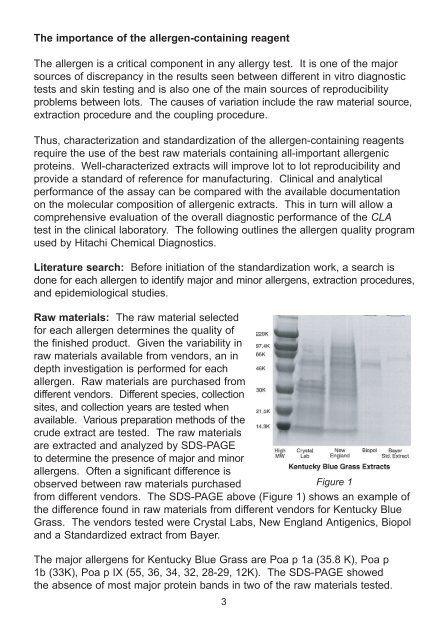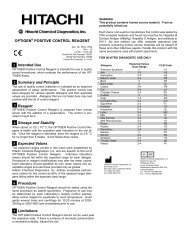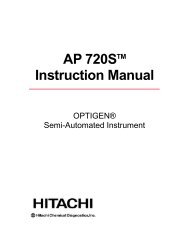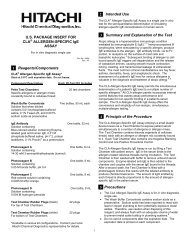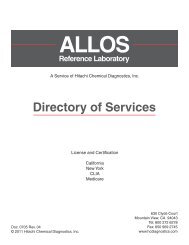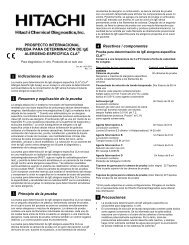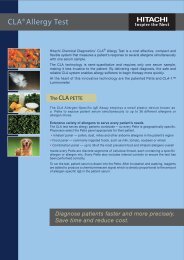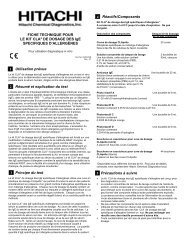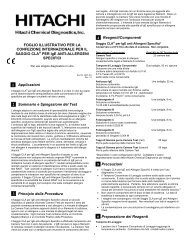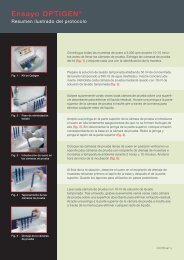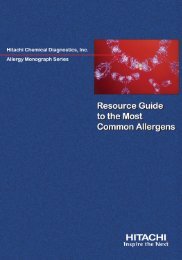Allergen Standardization Program - Hitachi Chemical Diagnostics
Allergen Standardization Program - Hitachi Chemical Diagnostics
Allergen Standardization Program - Hitachi Chemical Diagnostics
You also want an ePaper? Increase the reach of your titles
YUMPU automatically turns print PDFs into web optimized ePapers that Google loves.
The importance of the allergen-containing reagent<br />
The allergen is a critical component in any allergy test. It is one of the major<br />
sources of discrepancy in the results seen between different in vitro diagnostic<br />
tests and skin testing and is also one of the main sources of reproducibility<br />
problems between lots. The causes of variation include the raw material source,<br />
extraction procedure and the coupling procedure.<br />
Thus, characterization and standardization of the allergen-containing reagents<br />
require the use of the best raw materials containing all-important allergenic<br />
proteins. Well-characterized extracts will improve lot to lot reproducibility and<br />
provide a standard of reference for manufacturing. Clinical and analytical<br />
performance of the assay can be compared with the available documentation<br />
on the molecular composition of allergenic extracts. This in turn will allow a<br />
comprehensive evaluation of the overall diagnostic performance of the CLA<br />
test in the clinical laboratory. The following outlines the allergen quality program<br />
used by <strong>Hitachi</strong> <strong>Chemical</strong> <strong>Diagnostics</strong>.<br />
Literature search: Before initiation of the standardization work, a search is<br />
done for each allergen to identify major and minor allergens, extraction procedures,<br />
and epidemiological studies.<br />
Raw materials: The raw material selected<br />
for each allergen determines the quality of<br />
the finished product. Given the variability in<br />
raw materials available from vendors, an in<br />
depth investigation is performed for each<br />
allergen. Raw materials are purchased from<br />
different vendors. Different species, collection<br />
sites, and collection years are tested when<br />
available. Various preparation methods of the<br />
crude extract are tested. The raw materials<br />
are extracted and analyzed by SDS-PAGE<br />
to determine the presence of major and minor<br />
allergens. Often a significant difference is<br />
observed between raw materials purchased<br />
Figure 1<br />
from different vendors. The SDS-PAGE above (Figure 1) shows an example of<br />
the difference found in raw materials from different vendors for Kentucky Blue<br />
Grass. The vendors tested were Crystal Labs, New England Antigenics, Biopol<br />
and a Standardized extract from Bayer.<br />
The major allergens for Kentucky Blue Grass are Poa p 1a (35.8 K), Poa p<br />
1b (33K), Poa p IX (55, 36, 34, 32, 28-29, 12K). The SDS-PAGE showed<br />
the absence of most major protein bands in two of the raw materials tested.<br />
3


